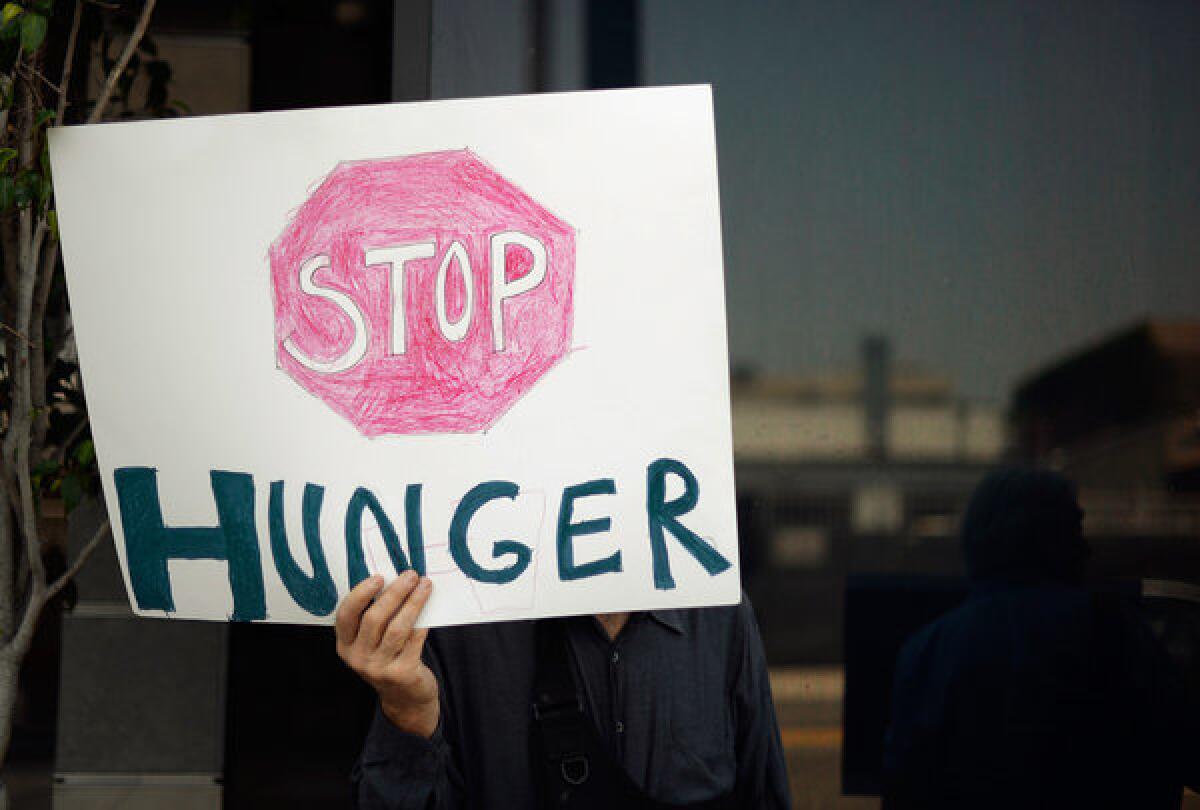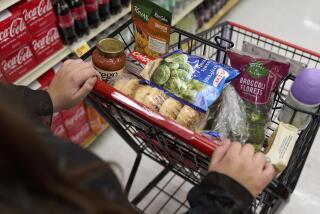Farm bill would cut aid to poor, add subsidies for farmers

- Share via
I realize that members of Congress have to suspend their sense of irony just to get through the day, but I’m still having trouble understanding how the House could consider cutting food stamps in the name of personal responsibility while creating new subsidy programs to preserve farmers’ incomes near their historic highs.
Food stamps and farm subsidies are joined at the hip in part because the former (a.k.a. the Supplemental Nutrition Assistance Program) is overseen by the federal Department of Agriculture, which also administers the panoply of farm supports. The combination is politically expedient too, or at least it has been, because it puts lawmakers from urban areas with high poverty rates on the same side as those from farming regions.
This year, though, the urban-rural coalition has been threatened in the House by the bill’s proposal to reduce food stamp spending by $20.5 billion over 10 years. That’s on top of the reduction in food stamp benefits scheduled for November, when the temporary boost Congress provided in the 2009 stimulus bill expires.
The $20.5-billion cut, which would shave less than 5% off the program’s budget, wouldn’t be deep. But with about 1 in 6 Americans on food stamps, even a trim has a sizable effect. In this case, it would cause an estimated 1.8 million people -- typically, the working poor Americans -- to lose their benefits, and an addition 1.7 million would see their benefits shrink.
I won’t argue the merits of the food stamp cuts here. It’s appalling that so many people are in the program still, four years after the economy started to climb its way out of the last recession. But I’m not swayed by the argument that food stamps breed dependency or discourage people from working. On the contrary, the data suggest that most people receiving the aid are trying to work their way out of poverty.
My main point is that it takes a special insensitivity to appearances to be able to propose a cut in food stamps while offering yet more welfare for farmers -- including giant agribusinesses that don’t need it.
The House proposes to do away with the “direct payments” program, an income-guarantee program that wrote checks to farmers based on acreage they farmed and the crops they historically planted. In its place, though, it has proposed new forms of protection that could prove to be even more expensive.
One, called “price loss coverage,” would have taxpayers cover the difference if crop prices fell below the federal target. An alternative, called “revenue loss coverage,” would have taxpayers fill in the gap when a farmer’s income falls below 85% of what it would have been had prices stayed at recent averages. The bill also would provide heavy subsidies for supplemental crop insurance policies that guaranteed up to 90% of a farmer’s income.
The common thread here is that the bill seeks to maintain farm incomes near their current levels, which are remarkably high. That’s not just a far cry from the ostensible purpose of farm programs (to protect vulnerable family farmers from ruin); it’s a potentially costly gamble, agricultural economist Vincent Smith of Montana State University opined Monday in U.S. News and World Report.
“If crop prices shift towards longer-run historical levels, taxpayers could face an estimated $16 to $20 billion in new farm subsidy costs,” Smith wrote. “That’s a lot of money, and most of it would go to the wealthiest farmers, corporations and landowners in the farm sector.”
According to the U.S. Public Interest Research Group, almost three-fourths of the subsidy dollars go to just 4% of the country’s farmers.
To their credit, some of the same conservatives who are eager to reduce spending on food stamps are calling for bigger cuts in farm subsidies. If they join forces with urban liberals, the House bill could be in big trouble.
The principle underlying the federal farm program is simple: To ensure a reliable food supply, farmers should be protected against the vicious ups and downs in harvests and crop prices. But policymakers have never been willing to take the most direct approach to the problem, which would be a means-tested system that helps only those farmers who run into trouble. One might even imagine a system of self-insurance, in which taxpayers are on the hook only when losses become catastrophic.
Considering the federal government’s fiscal problems, which contrast sharply with the healthy profits rung up by American farmers in recent years, now would be a good time for Congress to tackle the corporate welfare in the farm program -- not just the food aid in the farm bill.
ALSO:
Gun control: Close to bullet buyer loophole?
Drug patents: Pay-for-delay’s bad day in court
Genetic engineering and the alien wheat in Oregon
Follow Jon Healey on Twitter @jcahealey
More to Read
A cure for the common opinion
Get thought-provoking perspectives with our weekly newsletter.
You may occasionally receive promotional content from the Los Angeles Times.











